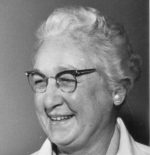In order to reduce infant mortality, Virginia Apgar, an obstetrical anesthesiologist[3] and medical researcher, is best known as the creator of the Apgar score, a fast evaluation of a newborn child's health after birth. She created the 10-point Apgar scale in 1952 to help medical professionals and nurses evaluate the health of babies. The Apgar test evaluates a baby's breathing, skin colour, reflexes,[6] movements, and heart rate at one minute and five minutes after delivery. She perhaps accomplished more than any other doctor to bring the issue of birth abnormalities out of the shadows, according to a friend. She pioneered obstetrical concerns in the well-known discipline of neonatology and was a pioneer in the domains of anaesthesia and teratology.
Life And Education
Helen May (Clarke) Apgar and Charles Emory Apgar's youngest child, Apgar, was born and reared in Westfield, New Jersey. Her father, a business leader and amateur astronomer, discovered an espionage network during World War I thanks to his amateur radio activity. Her other brother suffered from a chronic ailment, while her oldest brother passed very young from TB. She attended Westfield High School and graduated in 1925; she had known at an early age that she wanted to become a doctor.
Allen Whipple, the head of surgery at Columbia-Presbyterian Medical Centre, advised her against pursuing a career in surgery since he had seen several examples of women who had tried and ultimately failed to become great surgeons. Instead, he urged her to pursue a career in anesthesiology because he believed that improvements in this field were essential to advancing surgery and that she had the "energy and ability" to make a substantial impact. She trained for six months under Ralph Waters at the University of Wisconsin-Madison, where he had founded the nation's first anesthesiology department, after deciding to pursue a career in the field. She is the lone female in a 1937 portrait of Waters and his inmates, which also includes fifteen other men.

